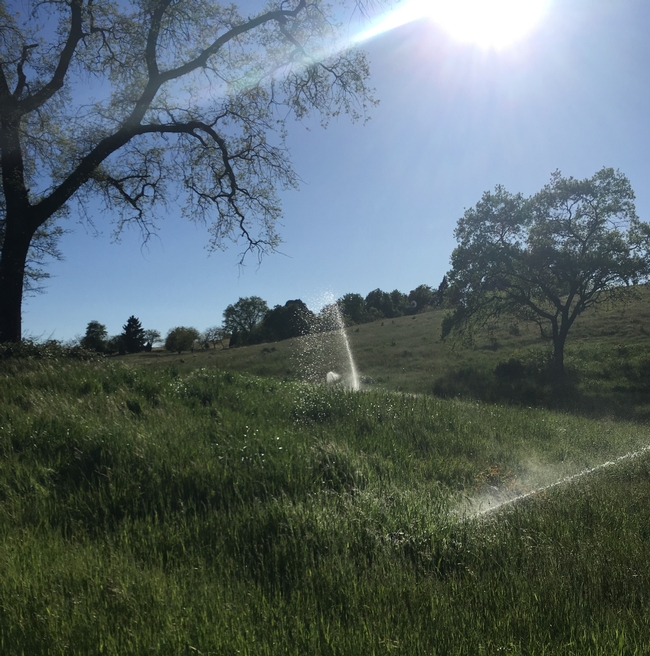If you're like me, you were probably surprised to look at the calendar this morning and realize that irrigation season begins in here in the Sierra foothills this week. With all that has been happening in our world (sheltering at home, socially distancing, washing my hands constantly), April 15 sneaked up on me this year. Nevertheless, the Nevada Irrigation District will begin delivering summer water in two days - I guess I'd better get ready for it!
I'm sure many of you are well ahead of me in terms of your preparations. You've probably cleaned out ditches, flushed mainlines, and checked sprinklers (depending on how you irrigate your pastures). We use a K-Line pod system for our small pasture near Auburn, so I'll spend Wednesday morning flushing lines and replacing broken sprinklers. I'll also lay out stakes with flags at the end of each set; our K-Line system is designed to run on 24-hour sets and a 12-day rotation. I'll start just about every day for the next six months dragging K-Line pods across our pasture.
If you plan to fertilize your pasture, now is the time to apply nitrogen. For a more comprehensive look at pasture fertilization, read "To Fertilize or Not to Fertilize" in my April 2020 newsletter. Here are the key points when it comes to applying nitrogen:
- Take species composition, water availability, and irrigation uniformity into account. Don't apply fertilizer if the pasture does not have adequate soil moisture at the time of fertilizer application nor if irrigation or rainfall are not possible in the near future.
- Consider collecting a nitrate soil test in the spring and fall. It's easy to collect, costs less than $20 per sample, and is a good way to see if fertilizer is needed shortly before application. It also allows you to develop a history of soil nitrate in your pastures, which will allow you to see trends. In the future, you may want to sample below the root zone to see if N is accumulating below the root zone and alter your irrigation management accordingly.
- Most irrigated perennial cool-season grass pastures will benefit from the application of 80-100 lbs. of nitrogen per acre applied in the springtime. It's not worth putting out less than 50 lbs. per acre – the application costs will be the same, but the boost in production will be lower.
- Don't apply N when establishing a new pasture – you'll only boost weed growth. Seedling grasses need more frequent irrigation then established grass. They can benefit from nitrogen after the seedling growth stage but only if weeds are not a problem or weeds are controlled with herbicides. Wait until the planted species have germinated and started growing before applying nitrogen.
Finally, don't neglect grazing management. Proper grazing management can greatly enhance forage production. Allowing forage to re-grow after it's been grazed (and before it's grazed again) will stimulate root growth and increase overall production. Avoid irrigating underneath your livestock - this will reduce the potential for soil compaction and will help protect water quality. Remember the 5 principles of managed grazing:
- Adjust your pasture rest periods to the growth rate of the plants. Our cool-season forage species will grow rapidly in the spring and fall; they'll go through a summer slump in hottest months. We can get by with shorter rest periods during times of rapid growth; we'll need to provide longer rest in July and August.
- Use the shortest graze period possible while maintaining adequate rest. We can make more efficient use of forage by using shorter graze periods - livestock will graze more if they're frequently going onto fresh feed.
- Use the higest stock density possible. Stock density will improve uniformity of grazing.
- Use the largest herd size possible consistent with sound animal husbandry principles. Fewer herds or groups of animals can simplify management considerations. Larger herd size also allows us to optimize beneficial impacts from hoof action and manure/urine deposition.
- Adjust stocking rate to seasonal changes in carrying capacity. During the spring flush and fall rebound, forage production can be substantially higher than during the hottest part of the summer. Some producers adjust to this seasonal fluctuation by harvesting hay. In our sheep operation, we use the spring flush to feed lactating ewes and growing lambs. As productivity decreases with warmer temperatures, we reduce our stocking rate by only grazing our replacement ewe lambs on our irrigated pasture. Come fall, when we're putting the ewes on a higher plane of nutrition in anticipation of breeding, we increase our stocking rate as forage productivity increases.
If you have questions about irrigated pasture management, contact me at dmacon@ucanr.edu or by phone at (530) 889-7385. Now if you'll excuse me, I need to go gas up the ATV and find my irrigation tools!
